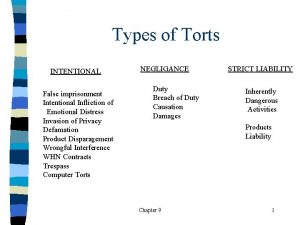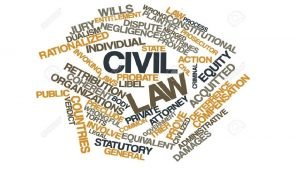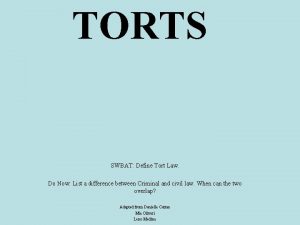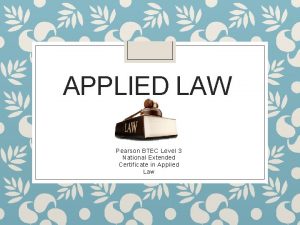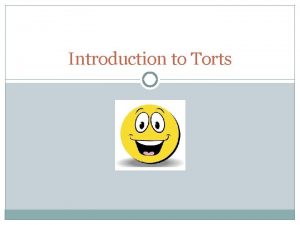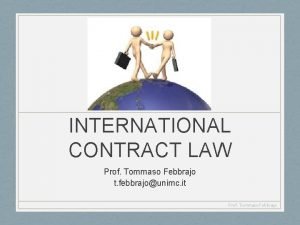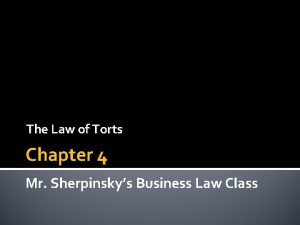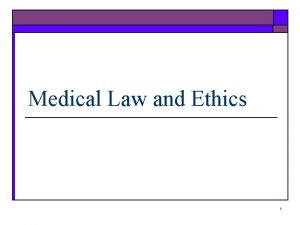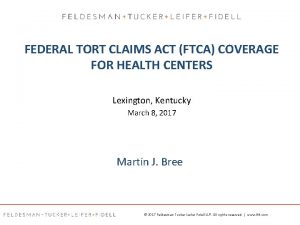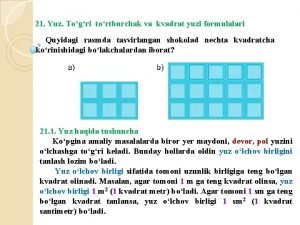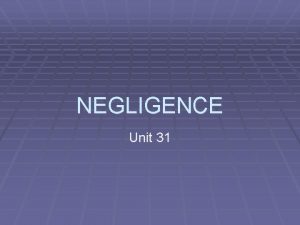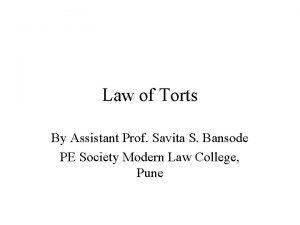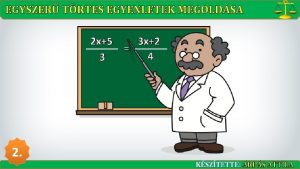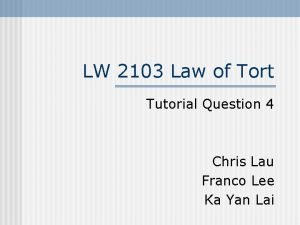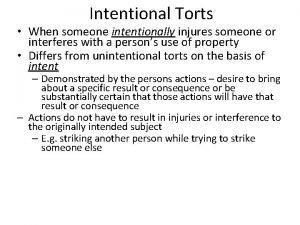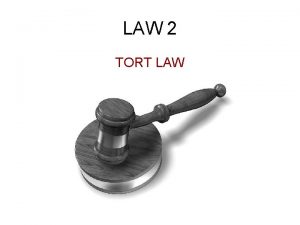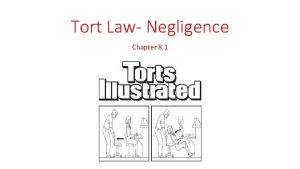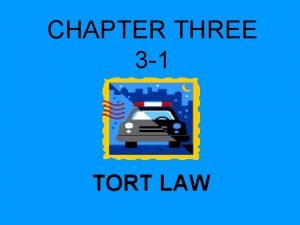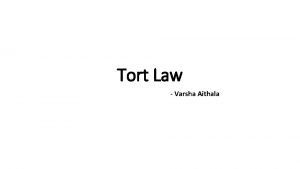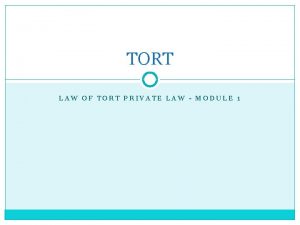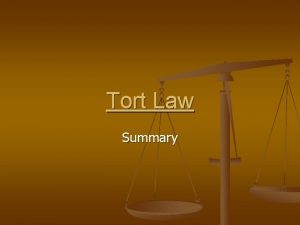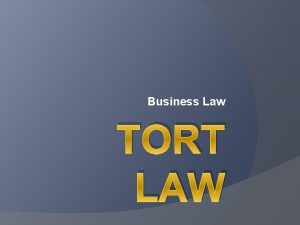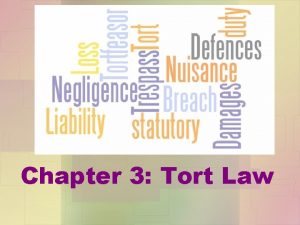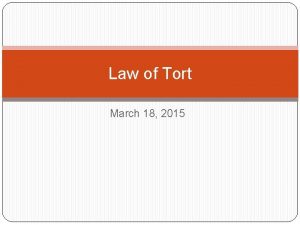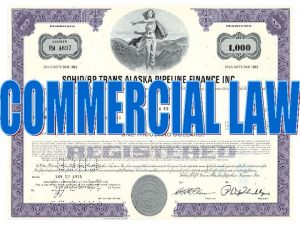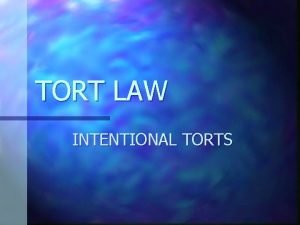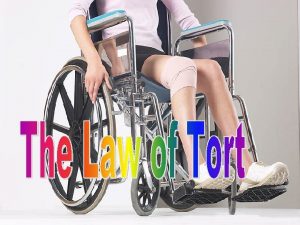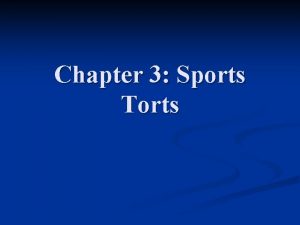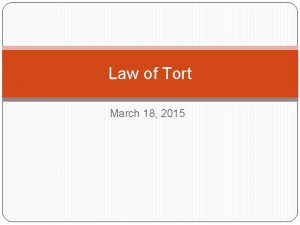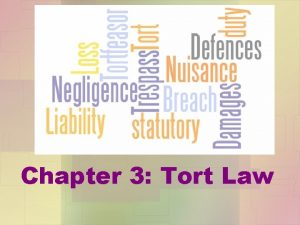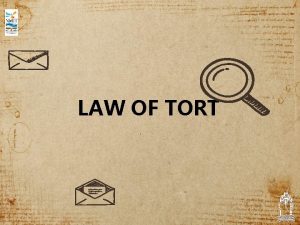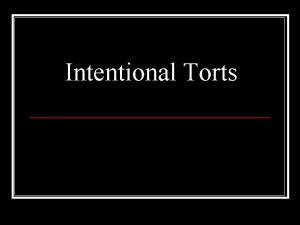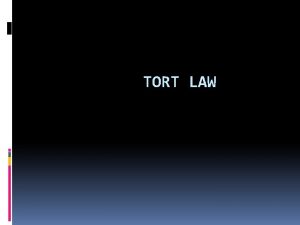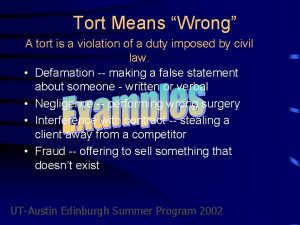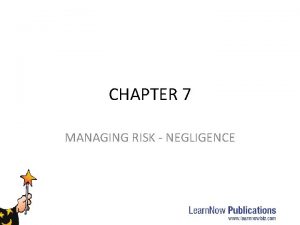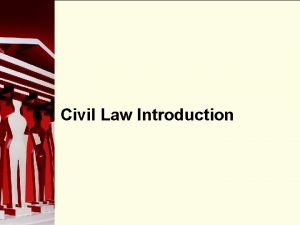UNIT 3 TORT LAW CIVIL LAW Most law

























- Slides: 25

UNIT 3 – TORT LAW

CIVIL LAW *Most law deals with civil law instead of criminal law *The primary goal of civil law is not to punish but to protect people by helping them avoid problems and resolve disputes � Tort Law – rules that govern civil wrongs › › When a crime is committed in civil law it is called a tort Largest area of civil law Deals with some of society’s most controversial issues Balances usefulness and harm while preserving individual choice › Encourages people to act responsibly by awarding money/damages to victims who are harmed by wrongdoers › Can be resolved by lawsuits, far more are settled without going to court › 90% of tort cases are settled without going to trial

LIABILITY � Tort law deals with 2 basic questions: 1. Who should be responsible, or liable, for harm caused by human activities? 2. How much should the responsible/liable person have to pay? *Almost any activity can be a source of harm. *Torts occur when one person causes injury to another’s property or reputation.

COMMON LAW � Laws that are made by a judge through court decisions � They are written down and become precedents used to decide future cases.

TYPES OF TORTS Intentional Wrong 1. › When a person acts with the intent of injuring a person, his or her property, or both › Can also be considered a criminal act � The defendant can be prosecuted by the state as well as sued by the plaintiff. � Civil tort action is used to recover monetary damages Negligence 2. › › Unintentional When a person fails to use reasonable care and causes harm Strict Liability 3. › › When the defendant is engaged in an activity so dangerous that there is a serious risk of harm even if he or she acts with the utmost care Plaintiff is not required to prove that the defendant was either negligent or intended to cause harm in order to recover damages

Taking Your Case to Court *In some situations, an act can be both a tort and a crime. This can lead to 2 separate actions (civil and criminal charges) � Standard of Proof › Amount of evidence the prosecutor must present in order to win the case in criminal court �Must prove beyond reasonable doubt that the defendant is guilty � Preponderance of the Evidence › Standard requires that to win in civil court, more than 50% of the evidence must be in the plaintiff’s favor *Civil standard is easier to meet than the criminal standard *Penalties for those found liable in a civil action are less severe than the penalties for those found guilty of a crime *A person does not go to jail for committing a tort, instead pays damages to those injured

WHO CAN BE SUED? � Almost anyone can be sued, including individuals, groups of individuals, organizations, businesses, and even units of government › People can sue employers for torts committed by employees in the course of their employment › Children/Minors who commit torts may be sued if it can be proven that they acted unreasonably for a person of that age and experience �The child’s parents are often sued as well *Plaintiffs try to sue a defendant who has enough money to pay for the damages.

WHO CANNOT BE SUED? � Immunity – certain defendants that are protected from some kinds of tort suits › Suits within families �Some exceptions are made �Husband Wives �Siblings �Parents and Children › Against governments and certain government officials or vice versa �The president, federal judges, and members of Congress are completely immune from tort liability for acts carried out within the scope of their duties

CLASS ACTION SUITS � Sometimes there can be more than one plaintiff or injured party by one action � These individuals are allowed to form a “class” and bring their law suit together � The settlement or damage award will be divided among the townspeople who bring the suit

PURPOSE OF INSURANCE � Used to protect an individual if accused of doing a wrong › When an accident occurs, the injured party can recover money from the wrongdoer’s insurance company, not from the wrongdoer.

Liability Insurance � Contract/agreement were a person agrees to make payments (premiums) to the insurance company, and the company agrees to pay for damages caused by the insured persons for the length of the contract › Companies set limits on how much they will pay › Companies do not cover intentional harm �Most doctors, lawyers, and other professionals carry liability insurance to protect themselves against malpractice suits �Manufactures often carry liability insurance to protect against lawsuits brought by consumers injured/harmed by their products �Home owners/Renters insurance provide coverage for loss and damage to insured property �Auto insurance protects possible losses by paying for repairs, medical bills, lost wages, pain and suffering from an injury

Auto Insurance � Medical Coverage › Pays for your medical expenses resulting from accidents caused by you › Pays for passengers in your car, no matter who is at fault � Collision Coverage › Pays for damage to your own car, even if the accident was your fault › Pays up to the actual value of the car � Comprehensive Coverage › Protects you against damage or loss to your car from causes other than collisions � Uninsured Motorist Coverage › Protects you from other drivers who do not have insurance or do not have enough insurance � Deductible › Amount that you agree to pay toward repairs before the insurance company pays anything › Can lower the cost of collision insurance

INTENTIONAL TORTS � Actions taken to deliberately harm another person or their property � 2 General Types of Intentional Torts 1. Those causing injury to persons 2. Those causing harm to property

Types of Damages � Compensatory Damages › A person who proves that someone else committed an intentional tort against him/her can recover damages to make up for the harm caused. › Future losses must be proved by the plaintiff › i. e. medical bills, lost wages, pain and suffering � Nominal Damages › Token amount of money awarded by the court to show that the claim was justified › Are awarded to recognize that the defendant acted wrongfully even though they did not cause substantial injury or loss.

� Punitive Damages › Amounts of money awarded to the plaintiff to punish the defendant for malicious, willful, or outrageous acts. * It is possible for both nominal and punitive damages to be warded even where there is little or no actual harm that would justify compensatory damages. * Sometimes people sued for intentional torts do not have to pay any damages at all, even though they did exactly what the plaintiff claims… the defendant may have a legal defense.

Torts That Injure Persons � Battery › Considered harmful or offensive contact that would offend the average person in society � Assault › Can be an intentional threat, show of force, or movement that causes a reasonable fear. › A plaintiff can recover compensation for mental disturbance, such as fright or embarrassment, along with any physical injury that directly results from the assault.

Infliction of Emotional Distress � Intentionally using words or actions that are meant to scare someone or cause them extreme anxiety or emotional distress. * Relatively new tort that was recognized since the 1940 s * Actual injury is not required for the plaintiff to recover damages * Plaintiff must prove extreme distress * Courts require that the defendant’s conduct be quite outrageous * Mere insults are not enough to form the basis of a lawsuit for emotional distress

False Imprisonment � Protects a person’s right to be free from unreasonable restraint � It occurs when someone intentionally and wrongfully confines another person against his or her will

Defamation : Protecting a Person’s Reputation Occurs when someone makes a false statement about another person that is communicated to a third party, causing harm to the person’s reputation � Includes acts that harm a person’s reputation and can be classified as oral or written � › Slander – oral statements that harm reputation › Libel – written statements that harm reputation * Damages are often more difficult to prove for slander than for libel * The law also protects opinion

Torts That Harm Property *Protects against interference with the owner’s exclusive use of the property *Protects against property being taken or damaged. � Real Property = land items attached to it › Trespass: entering property without permission � � Personal Property = property that can be moved Intellectual Property = creations of a person’s mind › Patent – recognizes ownership of an invention › Copyright – ownership of an expression › Infringement – person who uses patented or copyrighted work

Defenses to Intentional Torts � Consent › Written, spoken, or assumed agreement to something � Privilege › The right to speak or write personally damaging words because the law allows it. � Self-defense › The right to defend oneself with whatever force is reasonably necessary against an actual or reasonably perceived threat of personal harm. � Defense of property › The use of reasonable force, which would otherwise be illegal, to defen your home or other property.

Negligence ELEMENTS OF NEGLIGENCE 1. Duty › The defendant, or accused wrongdoer, owed a duty of care to the plaintiff, or injured person Breach of Duty 2. › The defendant’s conduct breached or violated the duty Causation 3. › The defendant’s conduct caused the plaintiff’s harm Damages 4. › The plaintiff suffered actual injuries or losses

Strict Liability � Defendant is liable to the plaintiff regardless of fault 1. Dangerous Activities � Toxic Torts 2. Animals 3. Defective Products

PUBLIC POLICY & TORTS Should compensate harmed persons in a prompt and efficient way 2. Fairly allocate benefits to victims and costs to wrongdoers 3. Deter conduct that is unreasonably risky or dangerous 1.

Tort Law Reform Arguments � Amount of money awarded to plaintiffs is sometimes unreasonably high � Going to court has become much too expensive with lawyers getting too much of the money awarded � Civil courts take too long to resolve disputes � Tort law is so complicated that it can be difficult to determine who is at fault � The injured party should sometimes receive compensation for a loss, regardless of whether the other party was at fault
 Define tort law
Define tort law Types of tort law
Types of tort law Dr alexander degazon
Dr alexander degazon Tort in law
Tort in law Tort in law
Tort in law Example of tort
Example of tort Civil rights and civil liberties webquest
Civil rights and civil liberties webquest Applied law unit 3 past papers
Applied law unit 3 past papers What is a civil law
What is a civil law Criminal law plaintiff
Criminal law plaintiff Common law and civil law
Common law and civil law Examples of civil law
Examples of civil law International contracts
International contracts Example of unintentional tort
Example of unintentional tort Types of criminal law
Types of criminal law Tort examples in healthcare
Tort examples in healthcare Federal tort claims act coverage
Federal tort claims act coverage Yuzini topish
Yuzini topish Tort titanic
Tort titanic Sayers v harlow
Sayers v harlow Injuria sine damno and damnum sine injuria difference
Injuria sine damno and damnum sine injuria difference Törtes egyenletek
Törtes egyenletek Törtek osztása természetes számmal
Törtek osztása természetes számmal Tort healthcare
Tort healthcare Tort lw
Tort lw Intentional tort
Intentional tort

